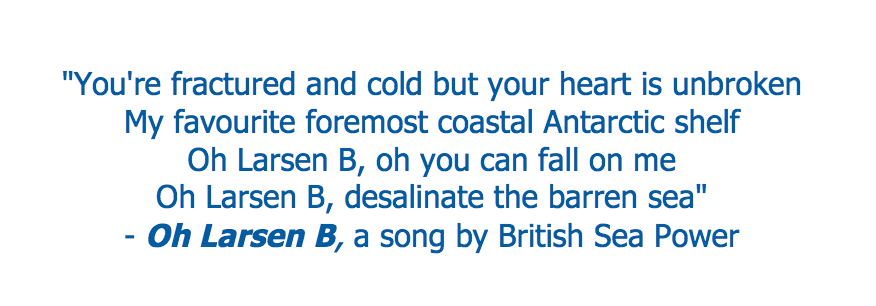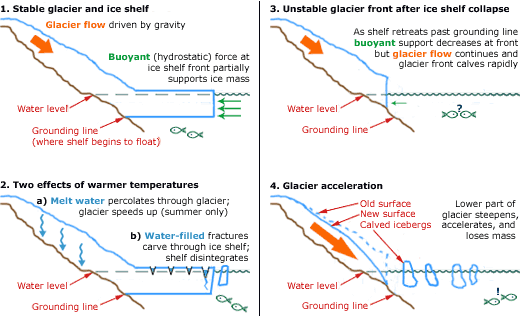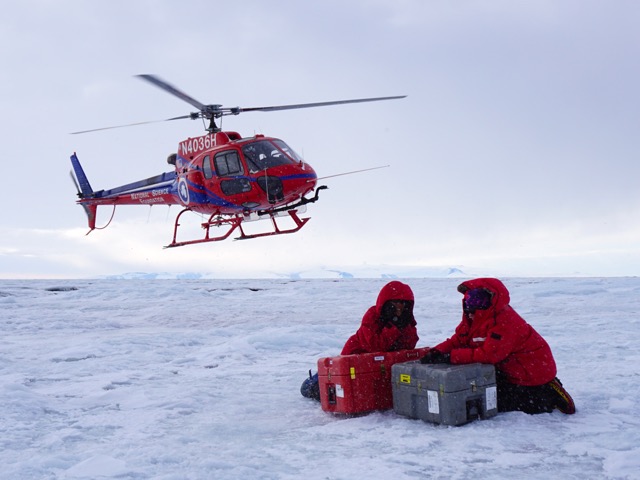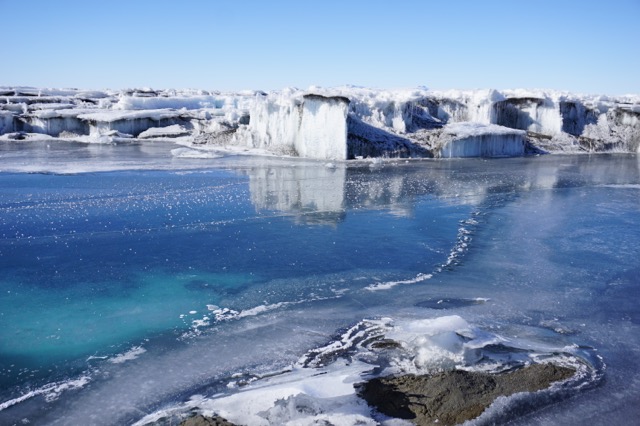MONDAY, 3 SEPTEMBER 2018

In 2002, the Larsen B ice shelf disintegrated into the Antarctic ocean in a mere span of two weeks. A floating mass of ice about the size of Cambridgeshire simply disappeared into the sea. This spectacular event not only inspired the lyrics to a British Sea Power song and sparked mass panic amongst environmentalists – it also motivated glaciologist Dr Alison Banwell to study the mechanism behind such a dramatic process.
Dr Banwell works at the Scott Polar Research Institute in Cambridge, where she and other climate scientists examine the state of the polar ice caps on both ends of the planet. In particular, she is interested in the stability of Antarctica’s floating ice shelves – how they become unstable, how they break up, why they have done so in the past, and, most importantly, why they may do so again in the future.
Ice shelves are large floating platforms of ice that extend out from ice sheets, which are grounded on bedrock. One common misconception is that melting ice shelves directly cause sea levels to rise. This, however, is not true. Since they are essentially large bodies of ice floating in the ocean, they displace a volume of water equal to their mass, and so melting creates no direct effect on sea level. (Try the following experiment at home: fill a glass with water and add enough ice such that the water level reaches the brim. Leave the glass in the sun for a few hours, and you will find that the melted ice does not cause the glass to overflow.) However, they are still of climatological importance. Dr Banwell explains: “Ice shelves buttress the inland glaciers from flowing into the oceans. If they go, the inland ice will accelerate and flow outwards, and that will cause sea level rise.”

So how exactly do ice sheets such as Larsen B disintegrate? It turns out that right before the breakup event, over two thousand lakes lying on top of the ice sheet suddenly and rapidly drained through the ice into the ocean below, each lake spanning up to ten kilometres wide. It has been suggested that the ice shelf fractured as a response to the change in stress due to the sudden drainage of such lakes. Dr Banwell, along with a colleague from the University of Chicago, Dr Douglas MacAyeal, modelled the effect of lake filling and drainage on ice shelves by approximating it to an already well-understood problem in engineering: the effect of a load on a flexible plate. Glaciers are dynamic. While they appear to be brittle on short timescales, they behave like a viscous fluid and can in fact flow on very long timescales. Dr Banwell’s research concerns the ice shelf ’s behaviour between these two extremes.
Dr Banwell’s computer models reveal something interesting. If a lake drains rapidly into the ocean, causing a change in local stresses, the ice shelf responds by fracturing around the lake. If these fractures were to occur beneath other lakes, those lakes would also drain rapidly, which in turn causes further fracturing. It could well be that this chain reaction mechanism was what caused Larsen B to break up so quickly.
Of course, models require corroboration from field evidence in order to have any form of explanatory power. “No one had any field measurements of ice shelf flexure or fracture in response to lake filling and drainage; no one really studied the lakes on ice shelves – or hadn’t, until our past two field seasons,” Dr Banwell says. “We went to the McMurdo ice shelf in Antarctica, in the northwest corner of the Ross ice shelf.”
Just before the start of the melt season, when supraglacial lakes form, Dr Banwell and her colleague Dr Ian Willis set out with the rest of the team on snowmobiles across the sea ice to designated field sites, where they installed pressure transducers and GPS devices on the ice shelf. These instruments are used to measure the rate of lake filling and drainage and ice shelf flexure respectively. Both instruments are incredibly precise, capable of measuring differences in height on a scale of millimetres to a centimetre.
The journey was not without peril. Dr Banwell recounts, “I drove a snowmobile over what I thought was simply ice, but it turned out to be a frozen-over lake. The whole thing collapsed and I got totally drenched. The snowmobile had to be pulled out by an enormous tractor. Luckily it was right next to the airstrip on the ice shelf, so there were lots of vehicles around to pull me out.”
 Scientists try to shelter from the strong updraft and spindrift from a helicopter as it takes off from the McMurdo Ice Shelf
Scientists try to shelter from the strong updraft and spindrift from a helicopter as it takes off from the McMurdo Ice ShelfThe team’s fieldwork yielded another fortuitous discovery. During their time at McMurdo station, they witnessed first- hand some smaller scale rifting and calving of the ice shelf, where masses of ice broke off the shelf to form icebergs. Using the data from their instruments, as well as seismometers and field cameras already installed by the staff at Scott Base, the team was able to undertake an unprecedented study of the rifting event.
While the exact mechanism behind this calving event remains unknown, this preliminary study identified the presence of high-energy sea swells just days before the breakup event, which point to energetic sea storms hundreds of kilometres away. If these storms were indeed responsible for the glacial breakup, it would help climatologists impose an additional order of sophistication to current climate models by including the complex interplay between atmospheric storm systems in the low latitude regions and glacial dynamics in the Antarctic.
Of course, further work remains to deepen our understanding of these complex processes. Would Dr Banwell like to traverse to the ends of the world once more? “Yes, I’d like to!” she exclaims. “We are in the process of writing more grant proposals to go again, maybe to another ice shelf on the Antarctic Peninsula in West Antarctica. That area of Antarctica is warming the fastest, and the ice shelves there are more vulnerable as they have more meltwater lakes.”
Should the trip happen, however, she and her team will not be enjoying the relative luxury afforded at McMurdo. “The Peninsula is logistically harder to get to. You can’t really stay in a field base, and you’ll be in the ‘deep field’. You will have to camp and get all the equipment flown in and then get collected a month or so later.”
To Dr Banwell however, it will be worth the trouble - it will help her improve her models and their predictive power. “Although the models I run are usually small-scale and quite theoretical, the results, along with the work of many other glaciologists, will ultimately be used in larger climate models,” she explains. These studies have profound implications in calculating the eventual amount of ice that will end up in the oceans, which in turn are an important factor further downstream in sea level predictions. We now have an improved picture of the future of our planet’s glaciers. But what of Dr Banwell? For her, the work continues. “I’m moving to the University of Colorado in Boulder, Colorado, where I will be taking on a two-year research fellowship to continue my study of ice shelves,” she says, bittersweetly, “although I will miss Cambridge. I’ve been here for almost 10 years. It is probably time to move away, at least for a bit.” The subject of her research may be icy cold, but her passion for glaciers is certainly anything but.
Seán Thór Herron is a 2ndand Silas Yeem Kai Ean a 3rd year Natural Scientist reading Earth Sciences. Twitter: @Silas Yeem. Images from the public domain. Photos from Alison Banwell.
 A meltwater lake on the McMurdo Ice Shelf. Above, under the title, a scientist conducts a LiDAR scan of the McMurdo Ice Shelf. The mighty volcano, Erebus, is behind.
A meltwater lake on the McMurdo Ice Shelf. Above, under the title, a scientist conducts a LiDAR scan of the McMurdo Ice Shelf. The mighty volcano, Erebus, is behind.